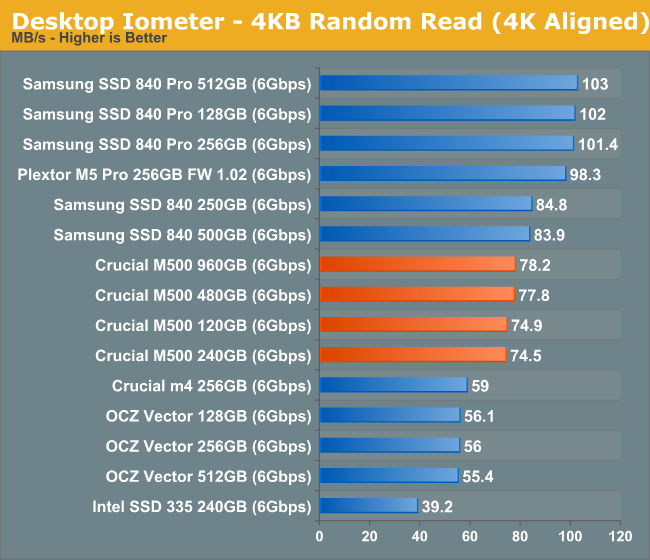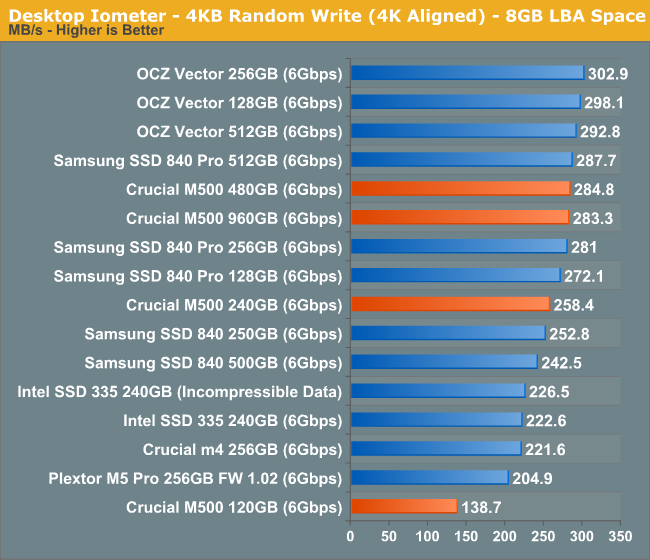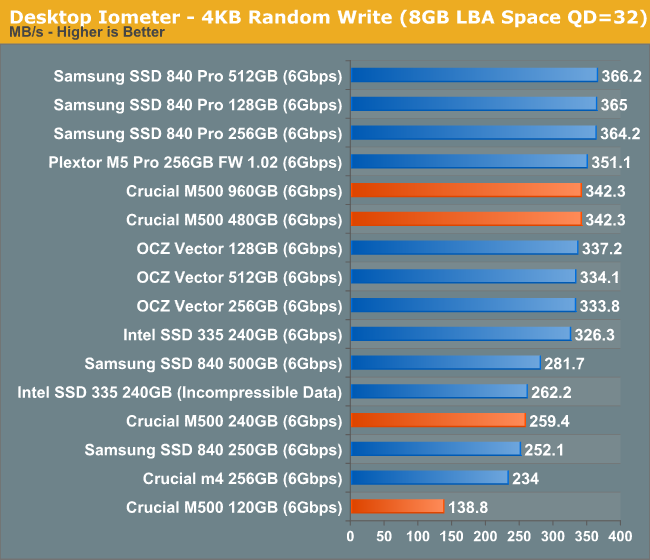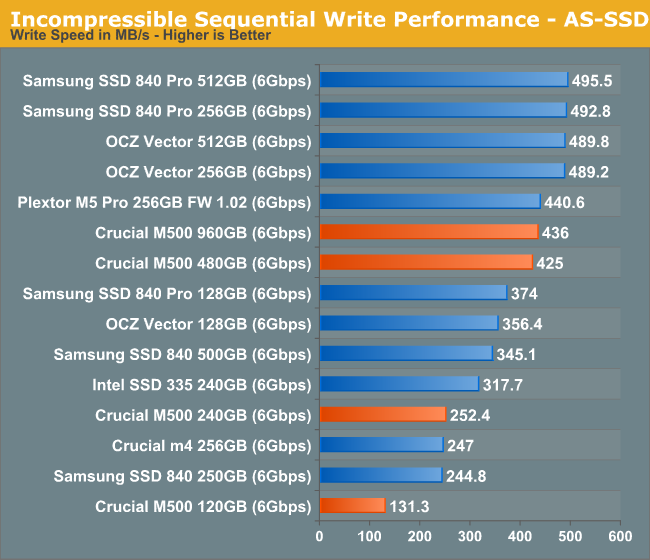The Crucial/Micron M500 Review (960GB, 480GB, 240GB, 120GB)
by Anand Lal Shimpi on April 9, 2013 9:59 AM ESTRandom Read/Write Speed
The four corners of SSD performance are as follows: random read, random write, sequential read and sequential write speed. Random accesses are generally small in size, while sequential accesses tend to be larger and thus we have the four Iometer tests we use in all of our reviews.
Our first test writes 4KB in a completely random pattern over an 8GB space of the drive to simulate the sort of random access that you'd see on an OS drive (even this is more stressful than a normal desktop user would see). I perform three concurrent IOs and run the test for 3 minutes. The results reported are in average MB/s over the entire time. We use both standard pseudo randomly generated data for each write as well as fully random data to show you both the maximum and minimum performance offered by SandForce based drives in these tests. The average performance of SF drives will likely be somewhere in between the two values for each drive you see in the graphs. For an understanding of why this matters, read our original SandForce article.

Random read performance starts out quite nicely. There's a good improvement over the old m4 and the M500 lineup finds itself hot on the heels of the Samsung SSD 840. There's not much variance between the various capacities here.

It's with the random write performance that we get some insight into how write parallelism works on the M500. The 480GB and 960GB drives deliver roughly the same performance, so all you really need to saturate the 9187 is 32 NAND die. The 240GB sees a slight drop in performance, but the 120GB version with only 8 NAND die sees the biggest performance drop. This is exactly why we don't see a 64GB M500 at launch using 128Gbit die.

Ramping up queue depth causes some extra scaling on the 32/64 die drives, but the 240GB and 120GB parts are already at their limits. There physically aren't enough NAND die to see any tangible gains in performance between high and low queue depths here on the smaller drives. This is going to be a problem that everyone will have to deal with ultimately, the M500 just encounters it first.
Sequential Read/Write Speed
To measure sequential performance I ran a 1 minute long 128KB sequential test over the entire span of the drive at a queue depth of 1. The results reported are in average MB/s over the entire test length.

Low queue depth sequential read performance looks ok but the M500 is definitely not class leading here.

There's pretty much the same story when we look at sequential writes, although once again the 120GB M500 shows its limits very openly. The 840 and M500 have similar performance levels at the same capacity point, but the M500 is significantly behind the higher end offerings as you'd expect.
AS-SSD Incompressible Sequential Read/Write Performance
The AS-SSD sequential benchmark uses incompressible data for all of its transfers. The result is a pretty big reduction in sequential write speed on SandForce based controllers.

Ramping up queue depth we see a substantial increase in sequential read performance, but there's still a big delta between the M500 and all of the earlier drives.

The high-queue depth sequential write story is a bit better for the M500. It's tangibly quicker than the 840 here.










111 Comments
View All Comments
philipma1957 - Thursday, April 18, 2013 - link
it is all about how much you want to pay. if you buy 1 960gb micron ssds and buy a pegasus r4. with 41tb hdds you can get a very fast booting mac setup. cost is 600 + 999 or 1600. pull one 1tb hdd from the pegasus and put in the micron 960gb ssd. you have a 1tb ssd as your boot drive and 3 x 1tb hdds for storage along with a 1tb hdd as a spare.. but that is a 1600 solution pretty high costUmika - Monday, April 22, 2013 - link
I have now one of these M500 SSDs and I have actually managed to lock me out of the drive using 3rd party OPAL TCG software. Now the printed PSID comes into play: I have downloaded the Seagate SeaTools utilities for Windows to try to crypto erase the SSD, but to no avail - the SeaTools always terminate with an error message. Is there any other openly available software to try to erase or PSID revert the drive to factory settings?gzon - Tuesday, April 23, 2013 - link
I am also experiencing problems with the OPAL encryption. Windows 8 does not seem to revert the disk back to manufactured-inactive state. Also tried PSID revert with SeaTools but it did not work. Where can I find software to PSID revert the disk?mikato - Tuesday, April 23, 2013 - link
"the key is just stored in the controller and everything is encrypted/decrypted on the fly"What happens if the controller breaks somehow and you need data recovery? You're just screwed? Of course backing up is the best way to go but we all know not many people do that and with these large SSD sizes they'll be taking on more data and not just an OS and programs that can always be reinstalled.
odedia - Sunday, July 21, 2013 - link
I can just drool over the thought of putting two of these in my 17 inch Macbook Pro. I currently have a 128gb Intel SSD and a 500gb spinning drive. This will be a serious upgrade, and I'll be able to RAID0 them together for better performance and easier drive management.littlesandra88 - Tuesday, August 27, 2013 - link
How can an ATA BIOS password not be secure, if it changes the password (makes a new hash)?paaraa - Friday, November 29, 2013 - link
People always keep hammering about the Samsung SSD's, but did you know about the bad block issue they have? Look up the 'SSD Endurnce Experiment' (the 200TB update) at Tech Report and you will see the bad block tally of the Samsung being way up there.New Egg current (black friday) has the 480gb M500 on sale for $279, pretty good. I have two M4's (128gb) and they have been great for years now.
Gallopsu - Monday, December 23, 2013 - link
This article mentions increased performance by 25% over provisiong. Is this something that must be configured in the bios or firmware. Or is it accomplished by simply not filling it to capacity. Or should only format it to 768GB and leave the rest untouched? How can I confirm that it is actually working? Would hate to give up that space and not get the benefits.clifforama - Tuesday, January 21, 2014 - link
Have you had any response from Crucial regarding how to perform a PSID reset/revert?bogdan_kr - Thursday, January 23, 2014 - link
Yes, I would like to know that too. Crucial has not provided any information on their forums but I guess they could possibly send some more specific information to you Anand :-)